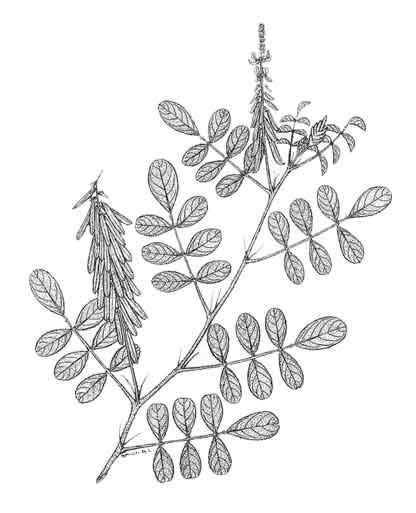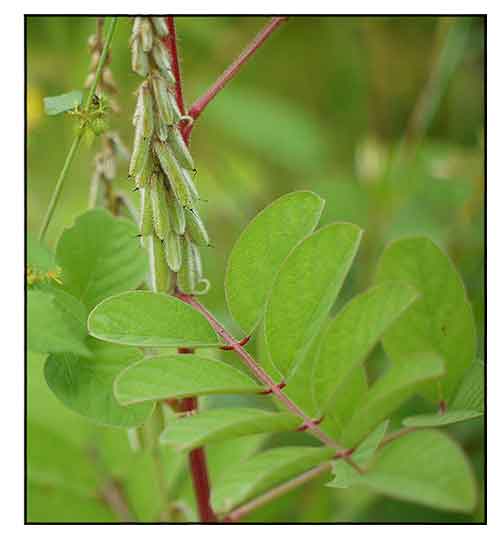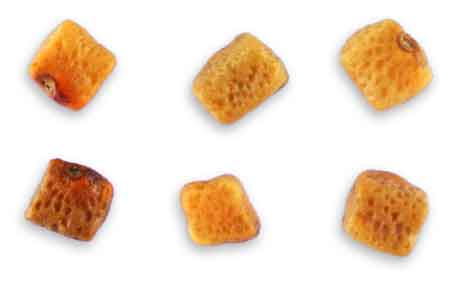 Gen info Gen info
- Indigofera is a large genus of about 700 species of flowering plants in the family Fabaceae / Leguminosae, occurring throughout the tropical and subtropical regions of the world. Species are mostly shrubs, some are herbaceous, a few are small trees.
- Etymology: The specific epithet hirsuta derives from Latin, which means "hairy", referring to the brown and rusty hairs that cover the stems and leaves.
Botany
• Taiuman is an erect, branched, annual, half-woody herb, growing from 0.4 to 1 meter high. Stems are reddish brown, and covered with spreading brown or purplish hairs. Leaves are 8 to 15 centimeters long. Stipules are linear, hairy, and 1 centimeter long. Leaflets are obovate, 5 to 11, 1.5 to 3 centimeters long, hairy, and pale beneath. Flowers are about 6 millimeters long, reddish purple, crowded in axillary racemes which are 6 to 20 centimeters long. Pods are straight, reflexed, 1.5 to 2.5 centimeters long, about 2.5 millimeters wide, covered with browns, spreading hairs, containing 4 to 6 seeds.
• Growth form: Shrublet or shrub with erect or spreading growth form, growing up to 1.5 m tall. Foliage: Compound leaves are typically composed of 5-7 elliptic to oblong leaflets, but sometimes up to 9 leaflets (4 cm long, 2.5 cm wide). Both sides of the leaf are pilose, being covered in long, soft hairs. Stems: Cylindrical stems are covered by orange-brown to reddish brown hairs. Flowers: Red to pinkish red, pea-shaped flowers are densely arranged in racemes (20-30 cm long). The standard (the large upper petal of the flower) is red to pinkish red with a white spot at the middle of the base. Fruit: Fruits are straight, narrow pods that are cylindrical to 4-sided (1.5-2 cm long, 2-2.5 mm wide). Pods are hirsute, being covered in stiff, brown hairs. The pods hang down in a dense chain that resembles a bottle brush. (18)
 Distribution Distribution
- Native to the Philippines.
-
In waste places in and about towns.
- Now pantropic.
- Also native to Angola, Assam, Bangladesh, Benin, Bismarck Archipelago, Bolivia, Borneo, Botswana, Brazil North, Brazil Northeast, Brazil South, Brazil Southeast, Brazil West-Central, Burkina, Burundi, Cambodia, Cameroon, Cape Verde, Central African Republic, Chad, China South-Central, China Southeast, Christmas I., Cocos (Keeling) Is., Comoros, Congo, Ecuador, Equatorial Guinea, Ethiopia, Free State, French Guiana, Gabon, Gambia, Ghana, Guinea, Guinea-Bissau, Gulf of Guinea Is., Guyana, Hainan, India, Ivory Coast, Jawa, Kenya, Laos, Lesser Sunda Is., Liberia, Madagascar, Malawi, Malaya, Mali, Mauritania, Mauritius, Mozambique, Myanmar, Namibia, New Guinea, New South Wales, Niger, Nigeria, Northern Provinces, Peru, Queensland, Réunion, Senegal, Sierra Leone, South China Sea, Sri Lanka, Sudan, Sulawesi, Taiwan, Tanzania, Thailand, Togo, Uganda, Venezuela, Vietnam, West Himalaya, Western Australia, Zambia, Zaïre, Zimbabwe. (4)
- Listed as an 'agricultural weed', 'cultivation escape', naturalised' and 'weed' in the Global Compendium of Weeds (Randall, 2012). It is listed as invasive in many parts of the Pacific, including French Polynesia, Palau, Nauru, Philippines, Singapore, Diego Garcia Island, and Mayotte Island. Also a known weed in the United States (Florida), China, Puerto Rico, and Brazil. In Australia, declared a "noxious weed" in the Northern Territory in 1918. (15)
 Constituents Constituents
- Yields indigo.
- Phytochemical screening yielded nine phenolic and six flavonoid compounds.
- Study yields high water soluble ash and total ash content, with acid insoluble ash in all parts.
-
Phytochemical analysis of leaf and fruit (mg/g) yielded total phenols of 50.7 (leaf/alcohol) and 123.9 (fruit/methanol), total flavonoids 30.21±0.04 (L) 32.07+0.03 (F), total alkaloids 15.20± (L) 18.25 ±0.03 (F), total saponins 0.13±0.01 (L) 0.25±0.04 (F). (see study below) (6)
- Study of aerial parts isolated two flavonol glycosides: Kaempferol-3-O-β-D-glucopyranoside (T2) and Kaempferol-7-O-β-D-glucopyranoside (Q3). (see study below) (7)
- Phytochemical screening of fruits yielded 14 phytoconstituents viz. alkaloids, flavonoids, phenols, glycosides, tannins, and steroids in the aqueous, methanol, alcohol, ethyl acetate and chloroform extracts. Anthocyanins, anthroquinones, carbohydrates, reducing sugars, proteins, lignins, saponins, and terpenoids were found in limited quantities. Fixed oils were absent. (see study below) (9)
- Study showed phenols were the largest group of phytoconstituents in leaf methanol extracts (124 mg/g), flavonoids
and alkaloids were highest in the fruit (32 mg/g and 18.25 mg/g, respectively). (10)
- Qualitative phytochemical screening of aerial parts yielded flavonoids, steroids, alkaloids, tannins, saponins, cardiac glycosides and anthraquinones. Quantitative evaluation yielded flavonoids (270.039 mg/100g), steroids (9.10 mg/100g),
alkaloids (59.74 mg/100g),
tannins (21.66 mg/100g),
saponins (1.3 mg/100g),
and anthraquinones (0.205 mg/100g). (see study below) (14)
- Phytochemical analysis of methanol extract identified an indolic dimer, cinnamic acids, phenolics, flavonoid glycosides, a cyclic polyol, the rare sugar 1-methyl-ß-D-glucopyranoside and glycerol. (see study below) (17)
Properties
- Considered expectorant, anthelmintic, hepatoprotective, stomachic and antidiarrheal.
- Studies have suggested anti-inflammatory, antibacterial, anticancer, radical scavenging, anticancer, anti-snake venom, lipoxygenase-enzyme inhibitoryproperties.
Parts used
Leaves, aerial parts, fruits.
 Uses Uses
Folkloric
- In the Philippines, decoction of fresh leaves given for diarrhea and as stomachic.
- In the Gold Coast, decoction of leaves used as lotion for yaws.
- In India, decoction of fresh leaves given for cerebral disorders.
- In Kenya, used for chest pains. In Tanganyika, whole plant preparation used as external application for back pain. Leaf decoction used for stomach ache and diarrhea. (9)
Others
- Agri: Grown as cover crop, forage plant, and green manure.
- Dye: Used to produce the an indigo dye.
Studies
• Antibacterial / Phytochemicals / Leaves:
Study of ethanolic and methanolic leaf extracts showed inhibition of four bacterial strains viz. Bacillus subtilis, E. coli, Staph aureus and Pseudomonas aeruginosa. Antibacterial activity was more effective than control drug Ampicillin. Phytochemical screening yielded nine phenolic and six flavonoid compounds. (1)
• Phytochemical Evaluation:
Study showed phenols are the largest constituents in leaf methanol extracts (124 mg/g); flavonoids (32 mg/g) and alkaloids (18.25 mg/g) are highest in fruit. (see constituents above) (6)
• Anti-Inflammatory / Flavonol Glycosides / Aerial Parts:
Study isolated two flavonol glycosides. The n-butanol soluble fraction exhibited significant anti-inflammatory activity in a carrageenan-induced paw edema model. (see constituents above) (7)
• Anti-Radical Activity / Aerial Parts:
Study of aqueous and methanol extract of aerial parts yielded tryptophan, uracil, rutin, kaempferal-3-O-ß-D-glucopyranoside, gallic acid and methyl gallate. Rutin, methyl gallate and gallic acid showed strong anti-radical activity. (8)
• Antibacterial / Fruits: Study evaluated various extracts of fruits for antibacterial activity against B. subtilis, S. aureus, P. aeruginosa, and E. coli. Methanol and alcohol extracts showed most effective antibacterial activity with lower concentration (0.019 to 0.039 mg) against all tested bacterial strains, compared with ampicillin 10 mg/ml. (see constituents above) (9)
• Silver Nanoparticles / Cytotoxicity Against Cancer Cell Lines / Antioxidant / Antibacterial / Leaves: Study reports on the biosynthesis of silver nanoparticles using aqueous leaf extract of Indigofera hirsuta. The AgNPs showed dose-dependent cytotoxicity against prostate cancer (PC3, IC50 68.5 µg/mL), colon cancer (COLO205, IC50 85.2 µg/mL), and mouse melanoma (B16F10, IC50 80.9 µg/mL). The AgNPs showed effective in vitro antioxidant activity against DPPH and H2O2 radicals and effective antibacterial activity against gram-negative and gram-positive bacteria. (11)
• Antibacterial / Aerial Parts: Study of crude extract of aerial parts exhibited significant activity against three test organisms i.e., Streptococcus pneumonia, Pseudomonas aeruginosa, and Shigella dysenteriae. Maximum activity was observed against S. pneumoniae with 12 mm at 200 mg/ml, 11 mm at 100 mg/ml, 10 mm at 50 mg/ml and 9 mm at 25 mm/ml. (see constituents above) (12)
• Antioxidant / Anti-Inflammatory / Anticancer / Roots: Study evaluated biological activities of root extracts of Indigo hirsuta and Afromosia laxiflora. I. hirsuta showed total phenolic and flavonoid contents of 54.38 mg and 116,093 mg/g, respectively. Indigo hirsuta decreased lipid peroxidation, inhibited RBC hemolysis and inhibited albumin denaturation, showed cytotoxic activity against HepG2 with IC50 of 95 µg/ml, and antimicrobial activity towards Pseudomonas aeruginosa, Staphylococcus aureus, E. coli and Vibrio species. Results showed antioxidant, anti-inflammatory, and anticancer activities. (13)
• Anti-Snake Venom Activity: Study evaluated butanol, methanol, and chloroform extracts for antivenin activity against Naja nigricollis venom using mice. Phytochemical screening of extracts yielded secondary metabolites such as alkaloids, flavonoids, tannins, steroids/terpenes, cardiac glycosides and saponins. Maximum protection was seen in ex vivo model at LD99+260 with 100% survival for all mice and a moderate survival rate (50%) at does of LD99+80. Appreciable protection was also observed in in-vivo model. Results confirmed the extracts of IH contains bioactive constituents with significant antivenin activity (p<0.05) under both ex vivo and in vivo conditions, supporting traditional claims for use in treatment of snake bite. (14)
• Analgesic / Anti-Inflammatory / Stigmasterol: Study evaluated the nethanol extract of Indigo hirsuta for analgesic and anti-inflammatory activities in mice. For analgesic activity, the extract significantly (p<0.01) inhibited acetic acid-induced writhing in mice at all test doses (150, 300, and 600 mg/kg) with maximum inhibition of 90.9% at 300 mg/kg. It also increased latency of pain reaction time comparable to pentazocine (20 mg/kg). For anti-inflammatory activity, all test doses significantly (p<0.01) reduced the progressive increase in paw edema diameter induced by carrageenan. At highest dose of 600 mg/kg, the extract was superior to piroxicam (10 mg/kg), a standard NSAID. The extract showed an intraperitoneal LD50 of 2154.1 mg/kg in mice. Phytochemical screening revealed flavonoids, tannins, saponins, steroids/triterpenes and alkaloids. Hexane soluble fraction led to isolated of stigmasterol, which may be responsible for the observed activities. (16)
• Antiradical / Enzyme Inhibitory: Study evaluated a methanol extract of I. hirsuta for antiradical potential and capacity for inhibiting lipoxygenase and aldose/aldehyde reductase enzymes. The ethyl acetate fraction derived from ME partition showed the highest antioxidant capacity, while the butanol fraction was strongest inhibitor of lipoxygenase enzyme. All fractions (diethyl ether, ethyl acetate, butanol, and aqueous residue) exhibited strong inhibition of both aldose/aldehyde reductase enzymes, agreeing with the ethnomedicinal plant utilization as an antidiabetic agent. (see constituents above) (17)
Availability
Wild-crafted. |

![]()



 Gen info
Gen info Distribution
Distribution
 Uses
Uses 